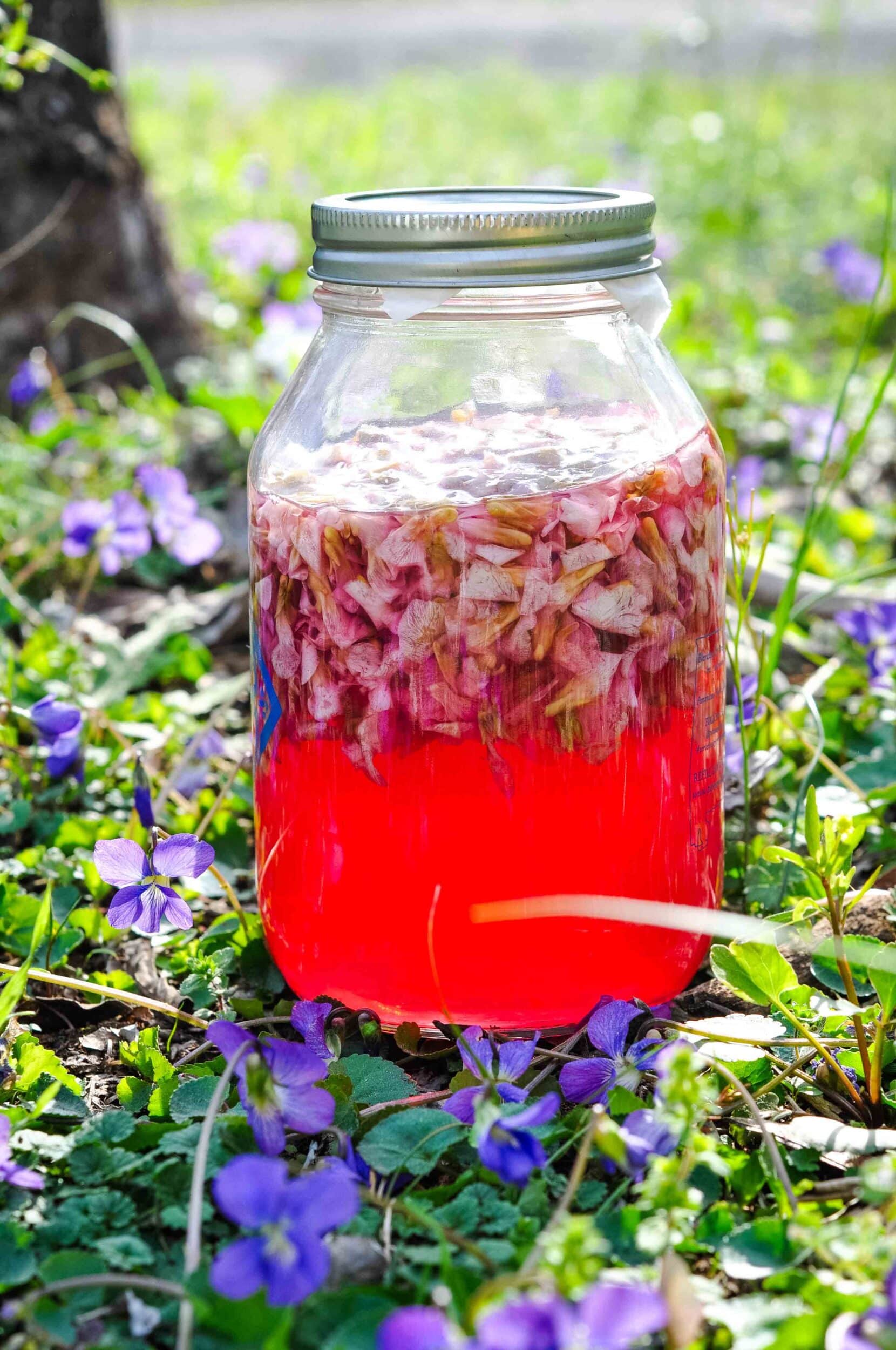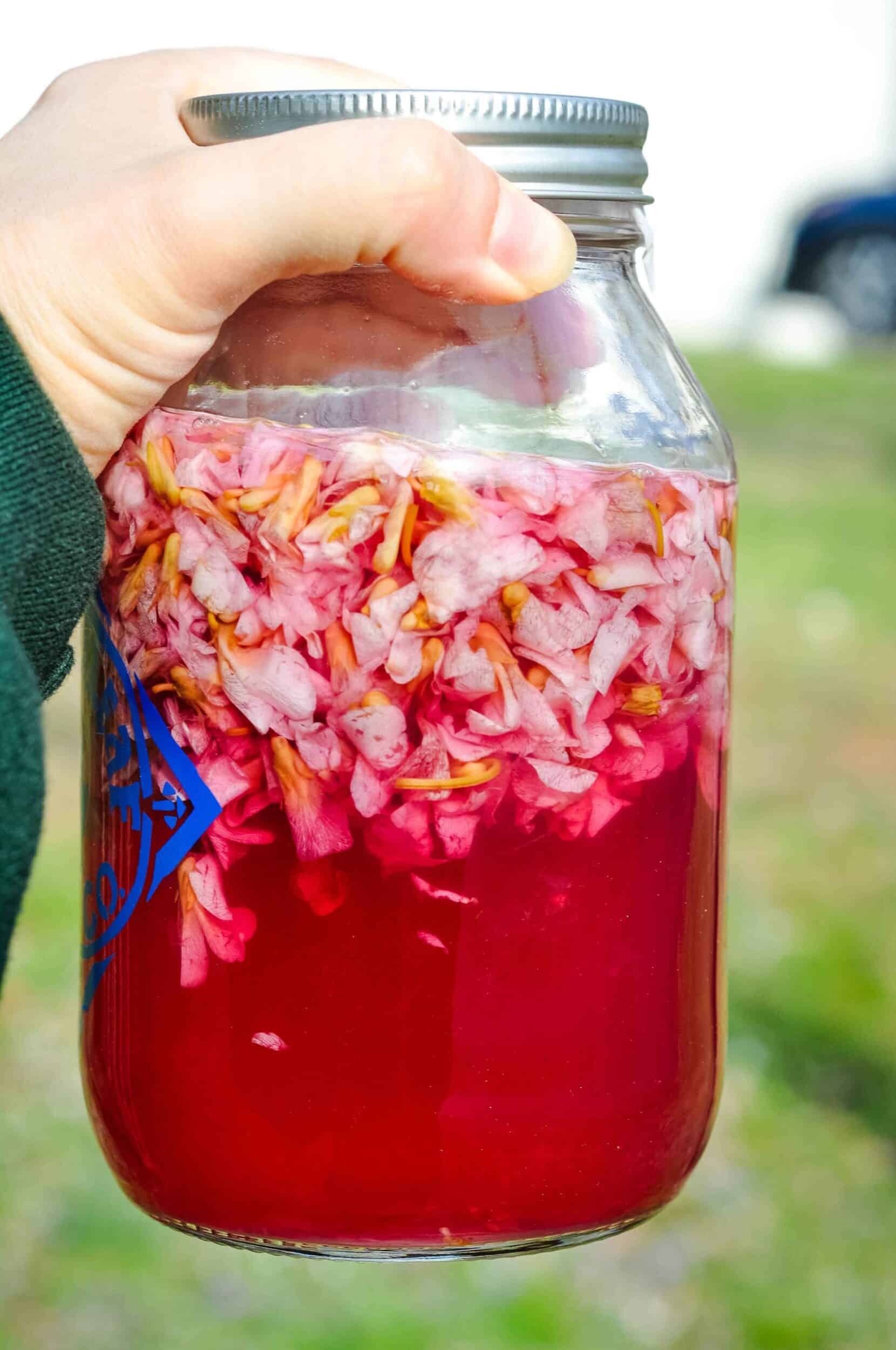Make this lovely wild violet vinegar as a fun way to celebrate spring! This purple violet infused vinegar can be used in salad dressings, marinades, and beverages too.

Foraging for wild violets
This spring our neighborhood was covered in a blanket of vibrant purple violets. These tiny bright flowers poking through the grass are often one of the first signs of spring. I love watching them sway in the breeze during my morning walks, and remembered they are edible even though I’ve never really consumed them before.
Then, I discovered you can use them in all sorts of ways, including making violet infused vinegar! This is a fun, easy springtime project that takes minimal effort, and it’s a fun activity to do with kids as well.
You want to make sure to forage wild violets from a yard that is not sprayed with pesticides. Foraging is great exercise too because it helps you get lots of squats in!

I highly recommend listening to Enya or some other meditative music while you forage your wild violets, and feel the sun kiss your face and breeze on your skin. Bliss.
P.S. Enya even has a song called Sumiregusa which means “Wild Violet.” How perfect is that! I love this quote on the inspiration of the song, which says:
In Sumiregusa all of nature is equal in its power to inspire, to move, to touch — from a small pebble to a great mountain, from one green leaf to the many colours of autumn, from the song of birds to a purple flower.
Notes by Roma Ryan
ENYA.COM: SUMIREGUSA WEBSITE, 2004

Benefits of wild violets
There are several benefits to using wild violets as an edible ingredient. They are known to be good for coughs and the respiratory system. They also contain vitamins like A & C and help boost the immune system.
Infusing the violets in vinegar gives it an inviting floral taste. It’s a great idea to take a little bit of the violet vinegar stirred into water, a beverage, or tea if you start to feel under the weather. You can even make a wild violet syrup or violet tea for medicinal use!
Ways to use violet vinegar
There are several different ways to use your violet vinegar after making it:
- stirred into a hot tea or other beverage with honey (good for immune system with a great boost of vitamin C)
- as part of a marinade for meats and veggies
- My favorite way — as the base for a salad dressing (recipe below)

Violet vinegar salad dressing
I made a fresh, fancy salad dressing with this lovely vinegar that I think you’ll love too! Here’s the recipe:
- 2 Tablespoons violet vinegar
- 2 tablespoons Olive Oil
- 1 Tablespoon honey
- Salt & pepper to taste
- A squirt of Dijon mustard
- Fresh spring herbs like parsley, rosemary, sage, etc. (optional)
Add all the ingredients to a small jar, shake to emulsify, and pour over your salad. This would be delicious on any salad, especially my caprese salad with grape tomatoes! You can add a few fresh violets into your salad to make it even more special!

How to Make Violet Vinegar
First, you want to forage for your wild violets! They range from deep purple to white and are common in many parts of the US and Canada. Violets grow low to the ground and have leafless stems and heart shaped leaves. Check out this post from Edible Wild Food for more info about how to identify wild violets and their unique characteristics.

Safety note: Use caution and be sure you identify the blooms correctly with foraging guides if you are unsure about the plant’s identity. Do not confuse wild violets with African violets, which are a common houseplant and are NOT edible.
Also, make sure they aren’t sprayed with pesticides. You will probably find some violets in your very own yard. Leave a few flowers behind to proliferate and share.
It’s best to forage mostly the purple violets instead of the white, as the purple ones give off the most color and the white won’t really impart much color to the vinegar.

You will forage however many flowers you need, depending on how much vinegar you want to make. The basic ratio is 1 part violets to 2 parts vinegar, but it’s forgiving. So if you want to fill a large 32 oz. jar, you’ll need around 2 cups of violets. For a smaller jar, a cup will do (or just a few handfuls, whatever you can harvest).

You want to infuse the vinegar pretty much immediately after harvesting the flowers, as they will begin to wilt and dry out quickly. Remove most of the stems, and wash the violets thoroughly in a colander to remove any dirt or debris.
Lay out the violets on a clean towel and pat dry. Add them to your jar of choice, filling the jar about halfway with violets.
Fill the jar with your vinegar of choice. I used apple cider vinegar, but you could also use white vinegar.

Cover the jar with a lid, preferably plastic. If you use a metal canning lid, like I did, add a square of parchment paper to the top of the jar first as the metal can react with the vinegar.
Store the jar in a cool dark place and allow it to infuse for 1-2 weeks. All the color will be drawn out of the flowers, and the vinegar will turn a gorgeous purple color! After this, strain out the flowers and it’s ready to use in salad dressings and beverages.
More herbal recipes to try:

Wild Violet Infused Vinegar
Make this lovely wild violet vinegar as a fun way to celebrate spring! This purple violet infused vinegar can be used in salad dressings, marinades, and beverages too.
Ingredients
- 1 cup wild violets
- 2 cups white or apple cider vinegar
Instructions
- Forage the violets from a pesticide-free yard and ensure you are identifying the plant correctly. Wash thoroughly and pat dry.
- Fill a jar halfway with violets, then cover with vinegar. Feel free to adjust the ratios depending on how much vinegar you want to make.
- Cover with a plastic lid (if using metal, cover with a square of parchment paper first to prevent metal from reacting with vinegar). Store in a cool dark place for 1-2 weeks.
- Strain the beautiful purple vinegar and use in salad dressings, marinades, and beverages.
Nutrition Information:
Yield:
32Serving Size:
1Amount Per Serving: Calories: 3Total Fat: 0gSaturated Fat: 0gTrans Fat: 0gUnsaturated Fat: 0gCholesterol: 0mgSodium: 1mgCarbohydrates: 0gFiber: 0gSugar: 0gProtein: 0g


Leave a Reply